I don’t get it. They’re colored lights. I think of my self as a pretty tech-savvy GenXer, and I’m kind of a lighting geek, but I can’t for the life of me figure out why I would want a lamp to be a particular color (other than 2800/3000/3200K) .
Note: I have 95CRI 3200K LED lighting in my kitchen and office where I spend most of my time and I have Caseta programmable/networked lights in the house. I’ve never felt the need to actually use the networking feature. What am I missing with Hue?


Very jealous. I’ve got about twenty bulbs and that covers my entire house. I think more lighting from more sources would be more pleasing.
It makes for more even lighting with relatively high max brightness and no dead spots. Rather than having multiple individual lights, nearly all of these areas are on high quality dimmers so if I want low or ambient light I can get it, and it achievable with a single control. My day job is in the architecture world (engineer) so I see what’s possible when someone is actively designing spaces for maximum comfort or utility. The first time I saw 98CRI/3200K gallery LEDs I was blown away. It would be another 5 years before prices would drop and I could afford (close to) that quality, but even then I had to seek it out.
Are there resources on lighting best practices? Would love to invest some money and energy here.
I’ve never been fully satisfied with the lighting in my living spaces.
Most of what I’ve learned has been walking through spaces and leafing through the project documentation and luminaire cut sheets the electrical engineer has compiled when I’m bored in meetings. There are online resources for best practice in lighting levels, and most fixtures (or lamps/“bulbs” when you’re talking PAR or reflector-style) have luminous intensity, fall-off curves, and angular illumination. Blackbody physics controls color in traditional incandescent lamps so you can get an idea of what temp you want from the equivalent wattage. I don’t know of any one source that walks through the options.